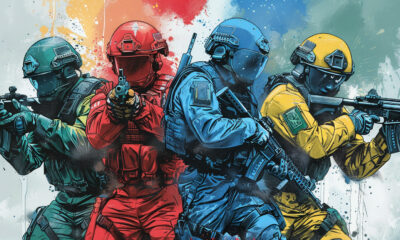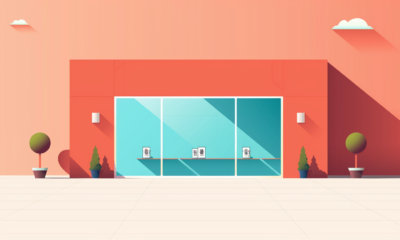MARKETING
If You Are A 21St-Century Business, You Better Be Cloud-ready

Cloud computing is a new innovative technology that many businesses have widely adopted in recent times. The public and private sectors have begun to use the cloud to shape their business architecture to obtain greater performance at lower costs. According to a study, in 2022, the worldwide public cloud computing industry will be worth $495 billion. Cloud technology is highly secure and allows businesses to increase their productivity. Many small businesses have benefited from cloud computing to take their business to the next level.
Cloud computing was introduced several years ago, but its popularity remains the same amid other rising technologies. There are countless reasons why businesses are driven toward cloud computing since it helps with everything from scaling infrastructure to delivering a web-based application. According to a study, the worldwide cloud applications market was worth $133.6 billion in 2021 and is anticipated to reach $168.6 billion by 2025. Businesses can focus more efforts on expanding their operations by migrating to flexible cloud solutions.
Cloud Computing:
Cloud computing allows businesses to access their apps and services and store their data securely. The advantage of owning a cloud is that the business does not need to worry about maintaining it. The storage size is infinite, and a system with an internet connection is enough. After adopting the cloud, enterprises have started to go with the flow of the continuous deployment model to avail of exciting features currently required for their day-to-day tasks.
Organizations looking to go with best practices can prefer cloud solutions to overcome challenges with less cost.
One of the most popular cloud myths is that companies have to spend a fortune to adopt an efficient cloud strategy. However, this couldn’t be farther from the truth. To get it right, businesses have to make their expectations clear and set realistic goals for their organization.
What are the different deployment models for cloud computing?
The public cloud allows anyone to access devices and services based on their needs. However, public clouds are less secure since anyone can use them. Public clouds offer cloud infrastructure via the internet for individuals and some industry groups. The cloud infrastructure is owned by entities, not consumers, for providing services. The public cloud concept for hosting mainly focuses on benefiting customers and users who make use of the services. It also benefits customers and users with free access to storage and retrieval services. Some of the key benefits of the public cloud are a minimal investment, dynamic scalability, no maintenance, no setup cost, and no infrastructure management required.
The private cloud deployment model is the opposite of the public cloud deployment model. It is appropriate for single users or customers. There is no need for individuals to share their devices with others to access the service. The private cloud is often referred to as an internal cloud, as it provides workers with access to the company’s systems and services. With the help of the IT department, the organization ensures that its cloud platform is secured and protected using powerful firewalls. A private cloud is flexible, and businesses can manage cloud resources efficiently. Some of the key benefits of the private cloud are customization options, better data security and privacy, being easy to control and supporting legacy systems.
After bridging the public and private clouds as software, the hybrid cloud concept evolved. Hybrid clouds take advantage of public cloud cost savings to allow businesses to host their apps safely. Hybrid clouds allow organizations to move data and apps as per their business requirements between different clouds by using two or more cloud deployment models. Some of the key benefits of the hybrid cloud are better security, cost efficiency, flexibility, and manageability. With cloud migration, businesses can migrate their data and apps easily.
Why are businesses driven toward cloud-ready solutions?
Cloud computing has started to rule every industry in the world after its launch in the market. Enterprises are finding better ways to cut down on costs for managing their businesses. Cloud-ready solutions are a one-stop solution that offers better security, reliability, and high-end performance to run businesses smoothly. Every organization can develop better applications with the help of hybrid strategies and give more importance to cloud-ready solutions for migrating these applications. After gaining access to cloud-ready solutions, business operations can now run seamlessly on cloud platforms with the proper network.
Legacy programs, such as locally operated servers developed for static computing environments, can be transformed to fit into the cloud environment, significantly saving resources. If businesses are looking forward to being cloud-ready, they have to accept the change to modify their workflow. With cloud-ready solutions, an organization can transform its traditional apps depending on its business needs. Most companies are willing to adopt the change to empower their apps with better cloud-ready solutions than writing and editing the codes. Cloud-ready solutions outperform their competitors in terms of accessibility and cost-efficiency. Have a look at the benefits offered by cloud-ready solutions:
Cloud-ready solutions benefit businesses by owning and maintaining the onsite infrastructure at a low cost by providing the same functionality.
It ensures enhanced security for cloud service providers and allows businesses to recover their data during a disaster easily.
Cloud-ready solutions enable businesses to access and experience real-time data, which can be quickly accessible and used to improve their overall productivity.
Organizations that deploy cloud-ready solutions can utilize the cloud’s resources based on their business needs.
How did edge computing gain the attention of enterprises?
Edge computing has recently acquired traction across a wide range of businesses, from small to large scale. Edge computing extends the cloud that adds more flexibility to the existing cloud model. It started to evolve with the deployment of IoT devices and 5G technology to compute efficiently, provide better storage, and collect accurate data using analytics. Edge computing helps businesses handle data securely, speeding up the process and delivering the data to people across the globe. Edge computing is accelerated with the help of 5G technology, which will allow for more efficient computing, better storage, and accurate data collection through analytics. Adopting edge computing solutions for businesses will help to reduce costs and process data quickly. There is no way for businesses to experience latency issues, network disturbances, and bandwidth limitations.
Wrapping Up:
The hype for cloud-ready applications is real. Many organizations have shown an interest in transforming their business landscape from on-premise solutions to cloud infrastructure. Cloud innovation is endless and benefits businesses from the lower total cost of ownership, fast adoption of the latest technologies, and continuous migration and upgrades. Cloud-ready apps are the next promising solution for businesses to manage complex IT infrastructure and gain flexibility. Enterprises willing to make their dreams come true with cloud-ready solutions at a low cost can connect with the world’s leading digital transformation consulting company to top the global market.
MARKETING
18 Events and Conferences for Black Entrepreneurs in 2024

Welcome to Breaking the Blueprint — a blog series that dives into the unique business challenges and opportunities of underrepresented business owners and entrepreneurs. Learn how they’ve grown or scaled their businesses, explored entrepreneurial ventures within their companies, or created side hustles, and how their stories can inspire and inform your own success.
It can feel isolating if you’re the only one in the room who looks like you.
MARKETING
IAB Podcast Upfront highlights rebounding audiences and increased innovation


Podcasts are bouncing back from last year’s slowdown with digital audio publishers, tech partners and brands innovating to build deep relationships with listeners.
At the IAB Podcast Upfront in New York this week, hit shows and successful brand placements were lauded. In addition to the excitement generated by stars like Jon Stewart and Charlamagne tha God, the numbers gauging the industry also showed promise.
U.S. podcast revenue is expected to grow 12% to reach $2 billion — up from 5% growth last year — according to a new IAB/PwC study. Podcasts are projected to reach $2.6 billion by 2026.
The growth is fueled by engaging content and the ability to measure its impact. Adtech is stepping in to measure, prove return on spend and manage brand safety in gripping, sometimes contentious, environments.
“As audio continues to evolve and gain traction, you can expect to hear new innovations around data, measurement, attribution and, crucially, about the ability to assess podcasting’s contribution to KPIs in comparison to other channels in the media mix,” said IAB CEO David Cohen, in his opening remarks.
Comedy and sports leading the way
Podcasting’s slowed growth in 2023 was indicative of lower ad budgets overall as advertisers braced for economic headwinds, according to Matt Shapo, director, Media Center for IAB, in his keynote. The drought is largely over. Data from media analytics firm Guideline found podcast gross media spend up 21.7% in Q1 2024 over Q1 2023. Monthly U.S. podcast listeners now number 135 million, averaging 8.3 podcast episodes per week, according to Edison Research.
Comedy overtook sports and news to become the top podcast category, according to the new IAB report, “U.S. Podcast Advertising Revenue Study: 2023 Revenue & 2024-2026 Growth Projects.” Comedy podcasts gained nearly 300 new advertisers in Q4 2023.
Sports defended second place among popular genres in the report. Announcements from the stage largely followed these preferences.
Jon Stewart, who recently returned to “The Daily Show” to host Mondays, announced a new podcast, “The Weekly Show with Jon Stewart,” via video message at the Upfront. The podcast will start next month and is part of Paramount Audio’s roster, which has a strong sports lineup thanks to its association with CBS Sports.
Reaching underserved groups and tastes
IHeartMedia toasted its partnership with radio and TV host Charlamagne tha God. Charlamagne’s The Black Effect is the largest podcast network in the U.S. for and by black creators. Comedian Jess Hilarious spoke about becoming the newest co-host of the long-running “The Breakfast Club” earlier this year, and doing it while pregnant.
The company also announced a new partnership with Hello Sunshine, a media company founded by Oscar-winner Reese Witherspoon. One resulting podcast, “The Bright Side,” is hosted by journalists Danielle Robay and Simone Boyce. The inspiration for the show was to tell positive stories as a counterweight to negativity in the culture.
With such a large population listening to podcasts, advertisers can now benefit from reaching specific groups catered to by fine-tuned creators and topics. As the top U.S. audio network, iHeartMedia touted its reach of 276 million broadcast listeners.
Connecting advertisers with the right audience
Through its acquisition of technology, including audio adtech company Triton Digital in 2021, as well as data partnerships, iHeartMedia claims a targetable audience of 34 million podcast listeners through its podcast network, and a broader audio audience of 226 million for advertisers, using first- and third-party data.
“A more diverse audience is tuning in, creating more opportunities for more genres to reach consumers — from true crime to business to history to science and culture, there is content for everyone,” Cohen said.
The IAB study found that the top individual advertiser categories in 2023 were Arts, Entertainment and Media (14%), Financial Services (13%), CPG (12%) and Retail (11%). The largest segment of advertisers was Other (27%), which means many podcast advertisers have distinct products and services and are looking to connect with similarly personalized content.
Acast, the top global podcast network, founded in Stockholm a decade ago, boasts 125,000 shows and 400 million monthly listeners. The company acquired podcast database Podchaser in 2022 to gain insights on 4.5 million podcasts (at the time) with over 1.7 billion data points.
Measurement and brand safety
Technology is catching up to the sheer volume of content in the digital audio space. Measurement company Adelaide developed its standard unit of attention, the AU, to predict how effective ad placements will be in an “apples to apples” way across channels. This method is used by The Coca-Cola Company, NBA and AB InBev, among other big advertisers.
In a study with National Public Media, which includes NPR radio and popular podcasts like the “Tiny Desk” concert series, Adelaide found that NPR, on average, scored 10% higher than Adelaide’s Podcast AU Benchmarks, correlating to full-funnel outcomes. NPR listeners weren’t just clicking through to advertisers’ sites, they were considering making a purchase.
Advertisers can also get deep insights on ad effectiveness through Wondery’s premium podcasts — the company was acquired by Amazon in 2020. Ads on its podcasts can now be managed through the Amazon DSP, and measurement of purchases resulting from ads will soon be available.
The podcast landscape is growing rapidly, and advertisers are understandably concerned about involving their brands with potentially controversial content. AI company Seekr develops large language models (LLMs) to analyze online content, including the context around what’s being said on a podcast. It offers a civility rating that determines if a podcast mentioning “shootings,” for instance, is speaking responsibly and civilly about the topic. In doing so, Seekr adds a layer of confidence for advertisers who would otherwise pass over an opportunity to reach an engaged audience on a topic that means a lot to them. Seekr recently partnered with ad agency Oxford Road to bring more confidence to clients.
“When we move beyond the top 100 podcasts, it becomes infinitely more challenging for these long tails of podcasts to be discovered and monetized,” said Pat LaCroix, EVP, strategic partnerships at Seekr. “Media has a trust problem. We’re living in a time of content fragmentation, political polarization and misinformation. This is all leading to a complex and challenging environment for brands to navigate, especially in a channel where brand safety tools have been in the infancy stage.”
Dig deeper: 10 top marketing podcasts for 2024
MARKETING
Foundations of Agency Success: Simplifying Operations for Growth


Why do we read books like Traction, Scaling Up, and the E-Myth and still struggle with implementing systems, defining processes, and training people in our agency?
Those are incredibly comprehensive methodologies. And yet digital agencies still suffer from feast or famine months, inconsistent results and timelines on projects, quality control, revisions, and much more. It’s not because they aren’t excellent at what they do. I
t’s not because there isn’t value in their service. It’s often because they haven’t defined the three most important elements of delivery: the how, the when, and the why.
Complicating our operations early on can lead to a ton of failure in implementing them. Business owners overcomplicate their own processes, hesitate to write things down, and then there’s a ton of operational drag in the company.
Couple that with split attention and paper-thin resources and you have yourself an agency that spends most of its time putting out fires, reacting to problems with clients, and generally building a culture of “the Founder/Creative Director/Leader will fix it” mentality.
Before we chat through how truly simple this can all be, let’s first go back to the beginning.
When we start our companies, we’re told to hustle. And hustle hard. We’re coached that it takes a ton of effort to create momentum, close deals, hire people, and manage projects. And that is all true. There is a ton of work that goes into getting a business up and running.


The challenge is that we all adopt this habit of burning the candle at both ends and the middle all for the sake of growing the business. And we bring that habit into the next stage of growth when our business needs… you guessed it… exactly the opposite.
In Mike Michalowitz’s book, Profit First he opens by insisting the reader understand and accept a fundamental truth: our business is a cash-eating monster. The truth is, our business is also a time-eating monster. And it’s only when we realize that as long as we keep feeding it our time and our resources, it’ll gobble everything up leaving you with nothing in your pocket and a ton of confusion around why you can’t grow.
Truth is, financial problems are easy compared to operational problems. Money is everywhere. You can go get a loan or go create more revenue by providing value easily. What’s harder is taking that money and creating systems that produce profitably. Next level is taking that money, creating profit and time freedom.
In my bestselling book, The Sabbatical Method, I teach owners how to fundamentally peel back the time they spend in their company, doing everything, and how it can save owners a lot of money, time, and headaches by professionalizing their operations.
The tough part about being a digital agency owner is that you likely started your business because you were great at something. Building websites, creating Search Engine Optimization strategies, or running paid media campaigns. And then you ended up running a company. Those are two very different things.


How to Get Out of Your Own Way and Create Some Simple Structure for Your Agency…
- Start Working Less
I know this sounds really brash and counterintuitive, but I’ve seen it work wonders for clients and colleagues alike. I often say you can’t see the label from inside the bottle and I’ve found no truer statement when it comes to things like planning, vision, direction, and operations creation.
Owners who stay in the weeds of their business while trying to build the structure are like hunters in the jungle hacking through the brush with a machete, getting nowhere with really sore arms. Instead, define your work day, create those boundaries of involvement, stop working weekends, nights and jumping over people’s heads to solve problems.
It’ll help you get another vantage point on your company and your team can build some autonomy in the meantime.
- Master the Art of Knowledge Transfer
There are two ways to impart knowledge on others: apprenticeship and writing something down. Apprenticeship began as a lifelong relationship and often knowledge was only retained by ONE person who would carry on your method.
Writing things down used to be limited (before the printing press) to whoever held the pages.
We’re fortunate that today, we have many ways of imparting knowledge to our team. And creating this habit early on can save a business from being dependent on any one person who has a bunch of “how” and “when” up in their noggin.
While you’re taking some time to get out of the day-to-day, start writing things down and recording your screen (use a tool like loom.com) while you’re answering questions.


Deposit those teachings into a company knowledge base, a central location for company resources. Some of the most scaleable and sellable companies I’ve ever worked with had this habit down pat.
- Define Your Processes
Lean in. No fancy tool or software is going to save your company. Every team I’ve ever worked with who came to me with a half-built project management tool suffered immensely from not first defining their process. This isn’t easy to do, but it can be simple.
The thing that hangs up most teams to dry is simply making decisions. If you can decide how you do something, when you do it and why it’s happening that way, you’ve already won. I know exactly what you’re thinking: our process changes all the time, per client, per engagement, etc. That’s fine.
Small businesses should be finding better, more efficient ways to do things all the time. Developing your processes and creating a maintenance effort to keep them accurate and updated is going to be a liferaft in choppy seas. You’ll be able to cling to it when the agency gets busy.
“I’m so busy, how can I possibly work less and make time for this?”


You can’t afford not to do this work. Burning the candle at both ends and the middle will catch up eventually and in some form or another. Whether it’s burnout, clients churning out of the company, a team member leaving, some huge, unexpected tax bill.
I’ve heard all the stories and they all suck. It’s easier than ever to start a business and it’s harder than ever to keep one. This work might not be sexy, but it gives us the freedom we craved when we began our companies.
Start small and simple and watch your company become more predictable and your team more efficient.
-

 PPC6 days ago
PPC6 days agoHow the TikTok Algorithm Works in 2024 (+9 Ways to Go Viral)
-

 SEO5 days ago
SEO5 days agoHow to Use Keywords for SEO: The Complete Beginner’s Guide
-

 SEO7 days ago
SEO7 days agoBlog Post Checklist: Check All Prior to Hitting “Publish”
-

 MARKETING6 days ago
MARKETING6 days agoHow To Protect Your People and Brand
-

 SEARCHENGINES7 days ago
SEARCHENGINES7 days agoGoogle Started Enforcing The Site Reputation Abuse Policy
-

 PPC7 days ago
PPC7 days agoHow to Craft Compelling Google Ads for eCommerce
-

 PPC7 days ago
PPC7 days agoHow to Brainstorm Business Ideas: 9 Fool-Proof Approaches
-

 MARKETING7 days ago
MARKETING7 days agoElevating Women in SEO for a More Inclusive Industry













You must be logged in to post a comment Login